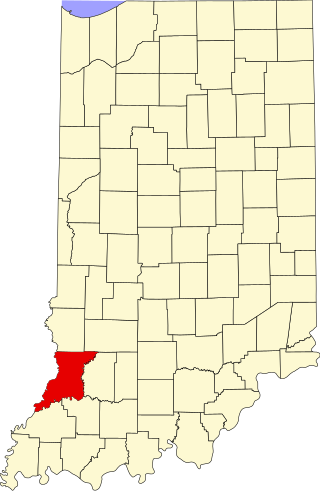
Vincennes is a city in, and the county seat of, Knox County, Indiana, United States. It is located on the lower Wabash River in the southwestern part of the state, nearly halfway between Evansville and Terre Haute. It was founded in 1732 by French fur traders, including the namesake François-Marie Bissot, Sieur de Vincennes. It is the oldest continually inhabited European settlement in Indiana and was its longest serving territorial capital. It is one of the oldest settlements west of the Appalachians. The population was 16,759 at the 2020 census.

The Indiana University School of Medicine (IUSM) is a major, multi-campus medical school located throughout the U.S. state of Indiana and is the graduate medical school of Indiana University. There are nine campuses throughout the state; the principal research, educational, and medical center is located on the campus of Indiana University Indianapolis. With 1,461 MD students, 195 PhD students, and 1,442 residents and fellows in the 2023–24 academic year, IUSM is the largest medical school in the United States. The school offers many joint degree programs including an MD/PhD Medical Scientist Training Program. It has partnerships with Purdue University's Weldon School of Biomedical Engineering, other Indiana University system schools, and various in-state external institutions. It is the medical school with the largest number of graduates licensed in the United States per a 2018 Federation of State Medical Boards survey with 11,828 licensed physicians.

George Rogers Clark National Historical Park, located in Vincennes, Indiana, on the banks of the Wabash River at what is believed to be the site of Fort Sackville, is a United States National Historical Park. President Calvin Coolidge authorized a classical memorial and President Franklin D. Roosevelt dedicated the completed structure in 1936.

Curtis Grover Shake, was a jurist, politician, author, and a member of the Indiana Senate who served as a Justice of the Indiana Supreme Court from January 4, 1938 to January 7, 1945, serving as Chief Justice three separate times. During his career, he was the presiding civilian judge over the IG Farben trial, one of the Nuremberg trials the United States convened at Nuremberg, Germany from 1947 to 1948 following World War II.

Francis Vigo, born Giuseppe Maria Francesco Vigo, was an Italian-American who aided the American colonial forces during the Revolutionary War and helped found a public university in Vincennes, Indiana.

During the 18th and early 19th centuries, the French, British and U.S. forces built and occupied a number of forts at Vincennes, Indiana. These outposts commanded a strategic position on the Wabash River. The names of the installations were changed by the various ruling parties, and the forts were considered strategic in the French and Indian War, the American Revolutionary War, the Northwest Indian War and the War of 1812. The last fort was abandoned in 1816.
Good Samaritan Hospital or Good Samaritan Medical Center may refer to:

Pierre Gibault was a Jesuit missionary and priest in the Northwest Territory in the 18th century, and an American Patriot during the American Revolution.

Freelandville or Freelandsville is an unincorporated community and census-designated place in Widner Township, Knox County, Indiana, United States. As of the 2010 United States Census it had a population of 643.

Good Samaritan Regional Medical Center is a 188-bed teaching hospital located in Corvallis, Oregon, United States. Founded in 1913, it is the only hospital in the city. The hospital operates a level II trauma center, and serves the Linn, Benton, and Lincoln County area. It is one of only 6 level II trauma centers in the State of Oregon. The hospital operates a number of residency training and fellowship programs for newly graduated physicians, psychologists, and pharmacists. It also has a partnership with Western University of Health Sciences College of Osteopathic Medicine of the Pacific, Northwest (COMP-NorthWest), the first Oregon medical school to open in more than 100 years.

George Washington Buckner was an American physician and diplomat. He was United States Minister to Liberia from 1913 to 1915.

This is a list of the National Register of Historic Places listings in Knox County, Indiana.

The St. Francis Xavier Cathedral is a historic Catholic church in Vincennes, Indiana, under the Diocese of Evansville. Named for Francis Xavier, the 16th-century Jesuit missionary, it is located opposite George Rogers Clark National Historical Park at 205 Church Street, within the Vincennes Historic District.
Conemaugh Health System, a member of Duke LifePoint Healthcare, is the largest health care provider in west central Pennsylvania, with multiple hospitals, physician offices, and outpatient centers in eleven counties. Conemaugh Health System is located in Johnstown, Pennsylvania.
Norman Frank Arterburn was an American lawyer, politician, and judge who served as a justice of the Indiana Supreme Court from May 23, 1955, to May 13, 1977.

Vincennes Historic District is a national historic district located at Vincennes, Knox County, Indiana. The district encompasses 1,161 contributing buildings, 5 contributing sites, 9 contributing structures, and 37 contributing objects in the central business district and surrounding residential sections of Vincennes. It developed between about 1787 and 1955, and includes notable examples of Federal, Greek Revival, Italianate, and Classical Revival style architecture. Located in the district are the separately listed George Rogers Clark National Historical Park, William Henry Harrison Home, Indiana Territorial Capitol, Old State Bank, and St. Francis Xavier Cathedral and Library. Other notable buildings include the Brouillet House, Knox County Courthouse (1873), Ellis Mansion, Lacy House, Dunn House (1840), Summers House, Fyfield House (1860), Grannan House, Cauthorn House, Gimble-Bond Store (1879), and Rabb House.
Isaac Kelley Beckes was the president of Vincennes University from 1950 to 1980. Before going to Vincennes he was the executive secretary of the United Christian Youth Movement. He is considered one of the initial leaders of a nationwide educational movement to add occupational programs alongside college transfer programs at two-year post-secondary institutions. He was also the first president of a two-year college to gain an exemption from the North American Interfraternity Conference and have national fraternities established at his school.
The Samaritan Health Services (SHS) is a non-profit, integrated delivery healthcare system consisting of five hospitals, over 110 physician clinics, and multiple health insurance plans in Oregon and is headquartered in Corvallis, Oregon. As of 2022 it is one of the top 10 largest non-profit employers in the State of Oregon with nearly 7,000 employees and volunteers. The Corvallis-based nonprofit was founded in 1997 when Mid-Valley Healthcare in Lebanon and Samaritan Inc. of Corvallis merged in an effort to more efficiently serve their communities. Over the years other organizations have joined Samaritan Health, such as FirstCare Health (Albany) in 1999, and the North Lincoln Health District (Lincoln City) in 2001 and Pacific Communities Health (Newport) in 2002. Samaritan Inc. began in 1948 when the Episcopal Church in Western Oregon, enabled the Corvallis General Hospital's reorganization as a not-for-profit facility.

Banner - University Medical Center Phoenix is a 746-bed non-profit, acute care teaching hospital located in Phoenix, Arizona, providing tertiary care and healthcare services to the Arizona region and surrounding states. Banner - University Medical Center Phoenix is a hospital of the Banner Health System and is one of the flagship facilities of the system. The hospital is affiliated with the University of Arizona Colleges of Medicine in Phoenix and Tucson. The hospital is an American College of Surgeons verified Level 1 Trauma Center and has a rooftop helipad to transport critically ill patients from within the region.
Samaritan Hospital is a community hospital in Troy, New York, and a founding member of Northeast Health System and managed by St. Peter's Health Partners. The main campus is at 2215 Burdett Ave Troy, New York. A second campus is located at the site of the former St. Mary's Hospital, also in Troy, while a third campus is at Albany Memorial.













